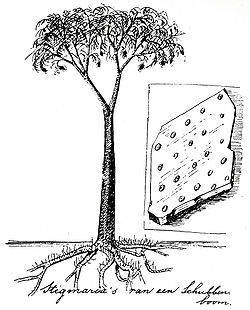User:Abyssal/Portal:Carboniferous
IntroductionThe Carboniferous (/ˌkɑːrbəˈnɪfərəs/ KAR-bə-NIF-ər-əs) is a geologic period and system of the Paleozoic that spans 60 million years from the end of the Devonian Period 358.9 Ma (million years ago) to the beginning of the Permian Period, 298.9 Ma. In North America, the Carboniferous is often treated as two separate geological periods, the earlier Mississippian and the later Pennsylvanian. The name Carboniferous means "coal-bearing", from the Latin carbō ("coal") and ferō ("bear, carry"), and refers to the many coal beds formed globally during that time. The first of the modern "system" names, it was coined by geologists William Conybeare and William Phillips in 1822, based on a study of the British rock succession. Carboniferous is the period during which both terrestrial animal and land plant life was well established. Stegocephalia (four-limbed vertebrates including true tetrapods), whose forerunners (tetrapodomorphs) had evolved from lobe-finned fish during the preceding Devonian period, became pentadactylous during the Carboniferous. The period is sometimes called the Age of Amphibians because of the diversification of early amphibians such as the temnospondyls, which became dominant land vertebrates, as well as the first appearance of amniotes including synapsids (the clade to which modern mammals belong) and sauropsids (which include modern reptiles and birds) during the late Carboniferous. Land arthropods such as arachnids (e.g. trigonotarbids and Pulmonoscorpius), myriapods (e.g. Arthropleura) and especially insects (particularly flying insects) also underwent a major evolutionary radiation during the late Carboniferous. Vast swaths of forests and swamps covered the land, which eventually became the coal beds characteristic of the Carboniferous stratigraphy evident today. The later half of the period experienced glaciations, low sea level, and mountain building as the continents collided to form Pangaea. A minor marine and terrestrial extinction event, the Carboniferous rainforest collapse, occurred at the end of the period, caused by climate change. Although the period is often asserted to have had higher atmospheric oxygen concentration than at present, estimates of prehistoric atmospheric oxygen concentrations are subject to considerable uncertainty, with some studies recovering atmospheric oxygen levels similar or lower than present values. (Full article...) Selected natural world article
Chitinozoa (singular: chitinozoan, plural: chitinozoans) are a taxon of flask-shaped, organic walled marine microfossils produced by an as yet unknown animal. Common from the Ordovician to Devonian periods (i.e. the mid-Paleozoic), the millimetre-scale organisms are abundant in almost all types of marine sediment across the globe. This wide distribution, and their rapid pace of evolution, makes them valuable biostratigraphic markers.
Their bizarre form has made classification and ecological reconstruction difficult. Since their discovery in 1931, suggestions of protist, plant, and fungalaffinities have all been entertained. The organisms have been better understood as improvements in microscopy facilitated the study of their fine structure, and there is mounting evidence to suggest that they represent either the eggs or juvenile stage of a marine animal. The ecology of chitinozoa is also open to speculation; some may have floated in the water column, where others may have attached themselves to other organisms. Most species were particular about their living conditions, and tend to be most common in specific paleoenvironments. Their abundance also varied with the seasons.(see more...) Did you know...
Need help?Do you have a question about Abyssal/Portal:Carboniferous that you can't find the answer to? Consider asking it at the Wikipedia reference desk. Selected image
Selected science, culture, or economics articleThe Bone Wars is the name given to a period of intense fossil speculation and discovery during the Gilded Age of American history, marked by a heated rivalry between Edward Drinker Cope and Othniel Charles Marsh. The two paleontologists used underhanded methods to out-compete the other in the field, resorting to bribery, theft, and destruction of bones. The scientists also attacked each other in scientific publications, attempting to ruin the other's credibility and cut off his funding. Originally colleagues who were civil to each other, Cope and Marsh became bitter enemies after several personal slights between them. Their pursuit of bones led them west to rich bone beds in Colorado, Nebraska, and Wyoming. From 1877 to 1892, both paleontologists used their wealth and influence to finance their own expeditions and to procure services and fossils from dinosaur hunters. By the end of the Bone Wars, both men exhausted their funds in fueling their intense rivalry. Cope and Marsh were financially and socially ruined by their efforts to disgrace each other, but their contributions to science and the field of paleontology were massive; the scientists left behind tons of unopened boxes of fossils on their deaths. The feud between the two men led to over 142 new species of dinosaurs being discovered and described. Several historical books and fictional adaptations have also been published about this period of intense paleontological activity. (see more...) GeochronologyEpochs - Mississippian - Pennsylvanian Landmasses - Gondwanaland - Laurasia - Pangaea Fossil sites - Bear Gulch Limestone - Hamilton Quarry - Mazon Creek fossil beds Researchers - Alfred Sherwood Romer
SubcategoriesQuality ContentFeatured Carboniferous articles - Amphibian Things you can doRelated contentAssociated WikimediaThe following Wikimedia Foundation sister projects provide more on this subject:
|






















